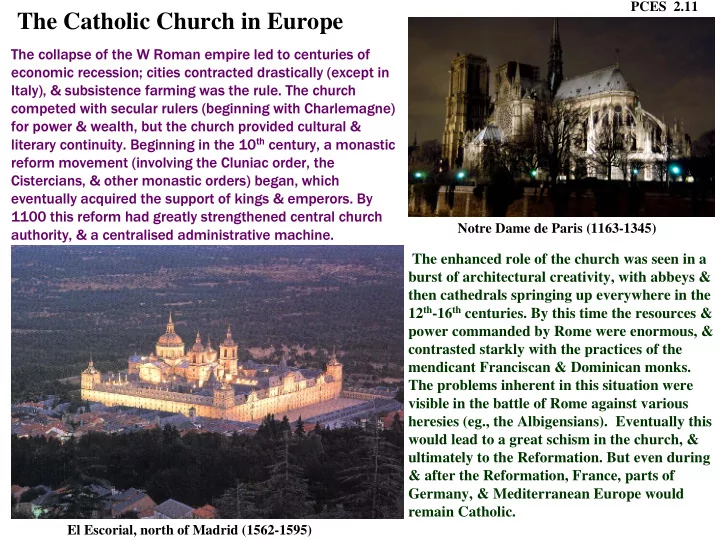

PCES 2.11 The Catholic Church in Europe The collap The collapse of the W Roman empire led t e of the W Roman empire led to centuries of centuries of economic reces onomic recession; cities contra ion; cities contract cted d ed drastically (excep tically (except in t in Italy), & subsis Italy), & subsistence farming was the r tence farming was the rule. Th le. The church e church competed with secular rulers competed with secular rule rs (beginning with C (beginning with Charlemagne) arlemagne) for power & wealth, but the church provided cultural & for power & wealth, but the church provided cultural & th centur y continuity. Beginning in the 10 th literary continuity. Beginning in the 10 literar century, a m y, a mona nastic stic reform movement (inv rm movement (involving the olving the Cluniac Cluniac order er, t , the e Cistercians, & other monast Cistercians, & other monastic orders) began, ic orders) began, which which eventually acquired t eventually acquired the supp e support of kings & emper ort of kings & emperors. B . By 1100 this reform had greatly st 1100 this r rm had greatly strengt rengthened ce ened centr ntral chu l church ch Notre Dame de Paris (1163-1345) aut authority, & a centr ority, & a centralised lised administ administrative machine. rative machine. The enhanced role of the church was seen in a burst of architectural creativity, with abbeys & then cathedrals springing up everywhere in the 12 th -16 th centuries. By this time the resources & power commanded by Rome were enormous, & contrasted starkly with the practices of the mendicant Franciscan & Dominican monks. The problems inherent in this situation were visible in the battle of Rome against various heresies (eg., the Albigensians). Eventually this would lead to a great schism in the church, & ultimately to the Reformation. But even during & after the Reformation, France, parts of Germany, & Mediterranean Europe would remain Catholic. El Escorial, north of Madrid (1562-1595)
PCES 2.12 Learning & Dogma in the Catholic World Catholic dogma in the late middle ages was a curious mish-mash of early ideas from Biblical scripture & various versions of the 4 th Nicean creed, (originating in 325 AD), along with later edicts of church councils & Papal bulls extending over a long period of time. Examples include the 1215 decision of the Lateran council’ to make confession & penance obligatory; the 1439 introduction of the 7 sacraments; & the various Papal bulls against withcraft. The philosophical underpinnings were a mixture of scripture, Platonism, & other Greek elements. These were malleable- for example, the ideas of Aristotle went from near heresy (at least in some quarters) to official orthodoxy during the 13 th century. However the core beliefs remained: in the supremacy of faith & revelation over reason and science, cemented early on by the writings of Paul, Augustine, & others; and in the spiritual supremacy of a Church separated from the state. Transl. of Aristotle, by N Oresme th centur By the By the 14 14 th century the Chur y the Church had ch had controlled the hearts controlled the hearts & minds of most & minds of most people i people in W W Europe for m Europe for many ny centuries– centuries– they had enjoy they had enjoyed for most of this ti d for most of this time a a monopoly o nopoly on liter literacy, s schoolin hooling, & o & on many ny of the most im of the most importa portant routines & t routines & rituals of everyday rituals of ev eryday life. The ris life. The rise of of th centuries universit universities in the 13 es in the 13 th th - 1 - 14 th centuries ev eventually beg entually began to challeng n to challenge the e the Intellectual authority Intellectual authority of the Churc of the Church. . Library in El Escorial
PCES 2.13 The Catholic Church & the Renaissance (I) By the 15 th century Italian wealth and power was concentrated in the Vatican, and in powerful city states like Firenze (Florence), itself run by the Medicis. Attempts to fight this (such as that of the fanatic Savonarola (1542-98)) were quelled ruthlessly. The sheer decadence of the Church in this period had been building for at least 2 centuries, and reached its height during the reign of Pope Alexander VI (Rodrigo de Borgia, r.1492-1503). At that time very few people doubted the basic tenets of Christianity, and the dominant theme in art and architecture was the glorification of God. The humanist ideal was shaped by many people, from writers such as Petrarch (1304-74) to artists such as Brunelleschi (1379-1446), Leonardo (1452-1519), and Michelangelo (1475-1564). Dome interior St. Peters dome , which Michelangelo completed (1546-64)
PCES 2.14 The Catholic Church & the Renaissance (II) Many of the things which figured large in the thoughts of people at this time can be seen in their art- sin, redemption, myths & magic, good & evil. Education was geared to the training of the clergy, and covered grammar, rhetoric, & logic- a hangover from the Graeco-Roman system, but now dogmatic. Literature and music were devotional. The renaissance brought A growing conviction that Man could control his own destiny, & admiration for ‘l’uomo universale’. Scenes from the Sistine Chapel (Michelangelo, painted from 1508-11).
Recommend
More recommend